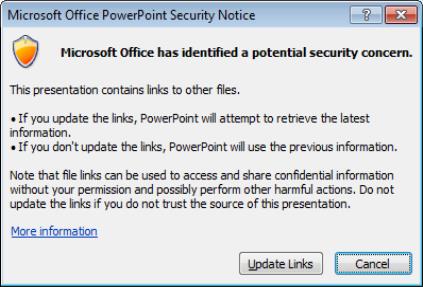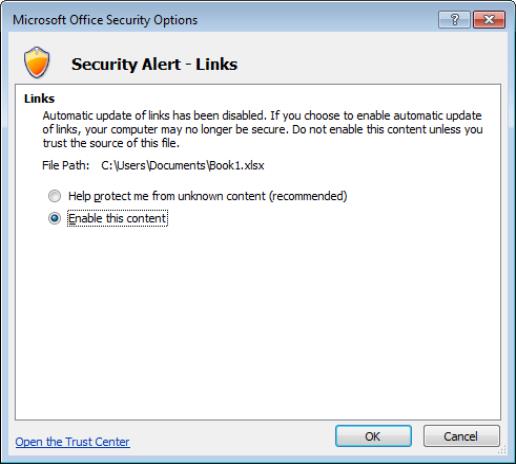Opening Documents with Linked Objects
When you open a Word document containing linked objects, you will be prompted to update the file.
Note that different applications handle this operation differently; some applications will update automatically on open, without a prompt.
If you are prompted to update, it does not imply that the linked object has changed within EViews. It is simply a notification that the document relies on data from EViews. If you choose not to update the file, the linked object will be made inactive during that session, and it will not receive updates from EViews. This means that your EViews graph and your linked graph can potentially be in different states.
To reactivate the link, right-click the graph in Word and select . You may also choose to update the next time you open the Word document. Note that for some applications, pressing the button in the EViews window (if it appears) can also reactivate the linked graph. However, this should not be relied upon. In some cases the button will be visible even though the linked object is inactive. You should always choose to update links when you open the document, if you intend for the links to be active.
When opening a PowerPoint document with links, you will see an ominous looking dialog, warning of security concerns.
If you are confident the only links contained in the file are EViews graphs and tables, this should be harmless. Choose to open the document and update the links, or select Cancel to open without linking for this instance.
The easiest security warning to miss may be Excel’s. Be aware that when you open an Excel document containing a linked table, you may not be seeing the updated data. You will instead see a security warning at the top of your document.
If this warning is visible, select next to the warning text to bring up a dialog that could be similar to this one.
If the only links within your document are from EViews, select , and click .
You can also tell when your Excel file is not in active link mode by looking at the associated series or group window. If the button is not visible, this can be an indication that the linked file is closed or is in inactive mode.
My External Application is Not Responding
If your application seems to be hung up, check EViews for a dialog awaiting your response. When you have embedded objects open in both EViews and another application, one may be waiting for a response before sending control back to the other. This state often occurs when you close a file with an embedded object that has not been updated and you attempt to save. EViews asks if you would like to update the object before saving. EViews will wait for your response, with this dialog open, before allowing the other application to close.




